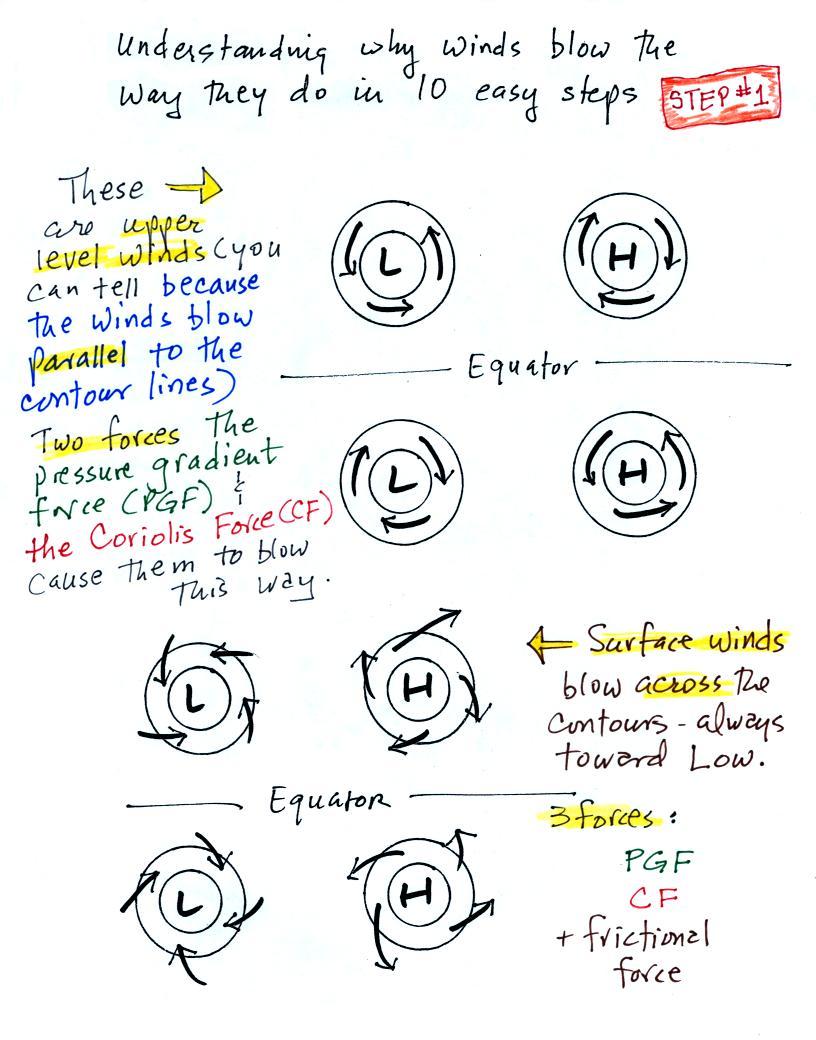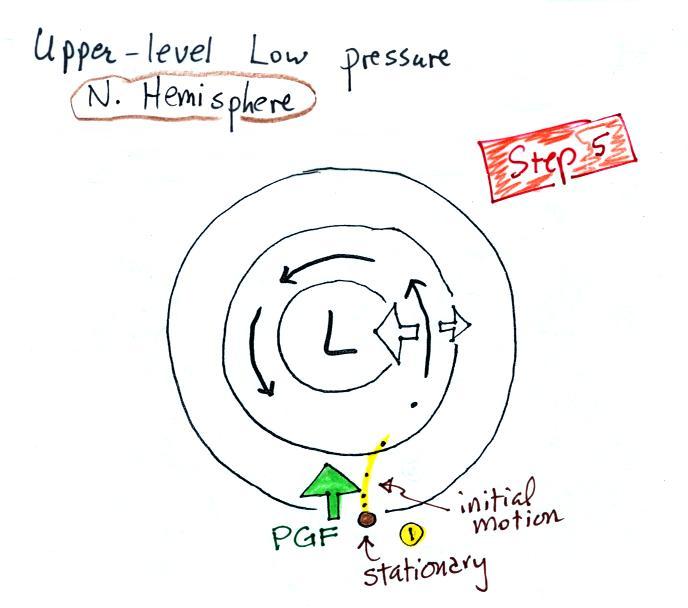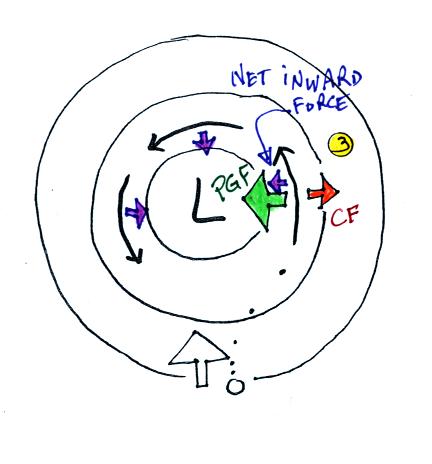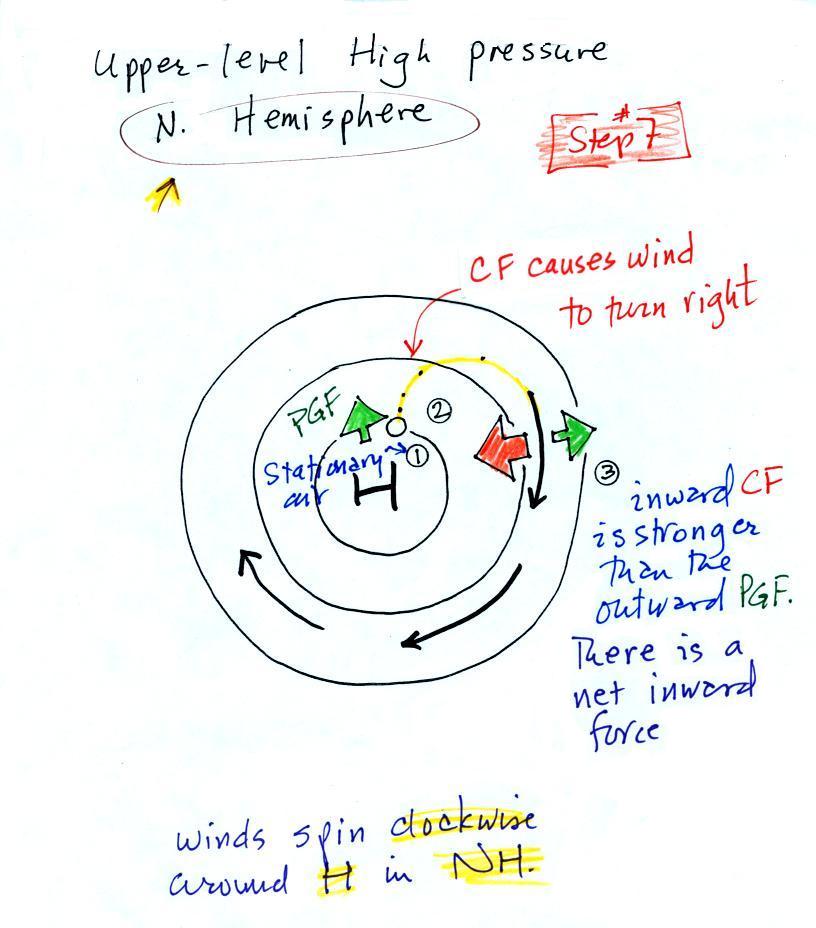In the
next two or three lectures we will be looking at how
and why
surface and upper level
winds blow the way they do.
Some real world examples of where this occurs are shown in the figure
below. The two largest types of storm systems, middle latitude
storms and hurricanes, develop around surface centers of low
pressure. Winds
spin counterclockwise around low in the northern hemisphere and
clockwise in the southern hemisphere. Winds spin clockwise around
"anticyclones" (high pressure) in the northern hemisphere and
counterclockwise in the southern hemisphere.
Storm systems in the tropics (0 to 30 degrees latitude) generally move
from east to west. At
middle latitudes (30 to 60 degrees), storms move in the other
direction,
from west to
east. To understand why this is true we need to learn something
about the earth's global scale pressure and wind patterns. This
is a topic we will be investigating also.
We'll learn about surface and upper level winds in both the
northern and southern hemispheres in 10 fairly straightforward steps.

Upper level winds spinning around high and low pressure in the
northern and southern hemispheres are shown in the first set of four
pictures. The first thing to notice is that upper level winds
blow parallel to the contours. We will see that 2 forces, the
pressure gradient force (PGF) and the Coriolis force (CF), cause the
winds to blow this way. Eventually you will be able to
draw the directions of the forces for each of the four upper level
winds examples. Here is an
example
of what you will be able to do.
The four drawings at the bottom of the page show surface winds blowing
around high and low pressure in the southern hemisphere. These
winds blow across the contour lines slightly, always toward low
pressure. The frictional force is what causes this to
occur. He is
an example of what you will be able to say about surface winds
blowing around low pressure in the southern hemisphere.
Before learning about the specific forces that cause the wind to blow
we will review one of Newton's laws of motion.

The motion in (c) above is in a straight line but the speed is
increasing. The examples in (d) and (e) show constant speed but
the motion is in a circle. There must be net forces in all three
cases. The directions of the net forces are shown in each
case. The bottom figure shows a horse running in a circle at the
end of a lunge line. The person exercising or training the horse
must pull inward to keep the horse running in a circle; it doesn't
matter what direction the horse is moving.
What is the direction of the net force in the three following examples.
The answers are shown in the figure below
A net inward force is needed in all three cases. It's just that
the amount of force is different. The amount of
force is "just right" in the top figure, a little "too strong" in the
middle figure, and "not quite strong enough" in the bottom figure.
Now we'll
start to look at the forces that cause the wind. We'll learn
rules for the direction and the strength of each force. Each
force will have a "unique" characteristic, it will do something that
the other forces don't always do.
A weather chart is analogous to a topographic map. Just like a
rock will always roll downhill (toward low altitude), the PGF will
always point toward low pressure. The PGF will start stationary
air moving toward low pressure.
The Coriolis force is caused by the rotation of the earth and always
points
perpendicular to the wind (to the right as you look downstream in the
northern hemisphere and to the left in the southern hemisphere).
It can only
change the wind's direction, it can't cause the wind to speed up or
slow down. You can learn more about the cause of the
Coriolis Force here.
Now we'll start to put everything together. We'll work through
this first example in a lot of detail. First, because this is an
upper level chart, we'll only need to worry about the pressure gradient
force (PGF) and the Coriolis force (CF).
We start with some stationary air at Point 1 in the figure above.
The PGF at Point 1
starts stationary air moving toward the center of low pressure (just
like a rock would start to roll downhill).
Once the air starts to move, the CF causes it to turn to the right
(because this is a northern hemisphere chart). As the air moves
inward it picks up speed, so the strength of the CF is increasing in
the figure above.
Eventually the wind ends up blowing parallel to the contour
lines. Note that the PGF and the CF are pointing in opposite
directions but are not of equal strength. The inward PGF is
stronger than the CF. The difference provides the net inward
force needed to keep the air blowing in a circular path. Winds
blow parallel to the contours and spin in a counterclockwise direction
around upper level lows in the northern hemisphere.
See if you can figure out what to do with this figure. When you
think you have the answer click here.
Now we'll look at the development of winds around upper level
centers of high pressure.
At Point 1, the PGF points outward toward low pressure. This
will cause the stationary air to begin to move outward (the initial
motion is shown with dotted lines)
Once the air starts to move the CF will begin to bend the wind to the
right.
The wind is blowing parallel to the contour lines at Point 3. The
PGF points outward. The inward pointing CF is stronger than the
PGF. The difference between the CF and the PGF provides the net
inward force needed to keep the wind blowing in a circular path.
Upper level winds spin clockwise around high pressure in the northern
hemisphere.
Try this example again on your own. When you think you have
the
answer, click here.
Now we'll look at surface winds. The PGF and CF still
play a role and we must add the frictional force to the mix.

The top figure shows upper level winds blowing parallel to
straight contours. The PGF and CF point in opposite directions
and have the same strength. The net force is zero. The
winds would blow in a straight line at constant speed.
We add friction in the second picture. It points in a direction
opposite the wind and can only slow the wind down. The strength
of the frictional force depends on wind speed (no frictional force if
the wind is calm) and the surface the wind is blowing over (less
friction over the ocean than when the wind is blowing over the land).
Slowing the wind weakens the CF and it can no longer balance the
PGF (3rd figure). The stronger PGF causes the wind to turn and
blow across the
contours toward Low. This is shown in the 4th figure.
Eventually the CF and Frictional force, working together, can balance
out the PGF. When this balance is reached the wind would continue
to blow in a straight line at constant speed across the contours.


The winds are spiralling inward in the top and bottom
examples (1 and 3).
These must be surface centers of low pressure. The winds are
spiraling outward from the centers of high pressure (2 and 4).
Now you probably don't want to figure out which of these are northern
and which are southern hemisphere pictures. It is probably best
to remember one of the pictures. I would suggest Example #1:
surface winds spin counterclockwise and spiral inward around centers of
low pressure in the northern hemisphere (something we learned fairly
early in
this course). Then remember that winds spin in the other
direction and blow outward around high pressure in the northern
hemisphere (2). The spinning directions of the winds reverse when
you move from the northern to the southern hemisphere. Thus you
find clockwise spinning winds and inward motion around low pressure (3)
and counterclockwise and outward spiraling winds around high pressure
in the southern hemisphere.
Earlier in the class we learned that converging surface winds create
rising air motions. Rising air expands and cools and can cause
clouds to
form. Clouds and stormy weather are associated with surface low
pressure in both hemispheres. Diverging winds
created sinking wind motions and result in clear skies.















